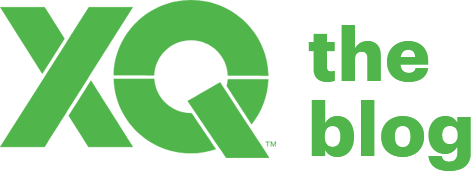Research shows that ninth grade is the “Make or Break Year” for high school graduation and college enrollment. Students who succeed academically their freshman year are far more likely to graduate high school and go to college—regardless of their background or prior academic achievement—and teachers have a significant role to play in creating the conditions that lead to academic success during this critical year.
There’s no better illustration of the phenomenon than “Eric,” a student I interviewed during his senior year at Hancock High School on Chicago’s Southwest Side. As a senior, he was secretary-general of the school’s Model U.N., a peer mentor, and a member of the school’s tech and pep squads. When meeting that confident, motivated senior, you would never guess he nearly failed three classes his freshman year and didn’t feel particularly connected to school at all back then. Eric credits his turnaround to a group of teachers in his freshman year who noticed he was struggling, reached out, and developed a plan to help him succeed. “That was when I started becoming more of a leader,” Eric reflected during an interview his senior year. “I started becoming more conscientious of my decisions. I think I realized after that that people actually cared and were mindful of what you do.”
In Chicago, concentrated, sustained efforts to support freshmen have led to remarkable improvements in ninth grade course performance and high school graduation rates. My book, The Make or Break Year, chronicles these efforts over a ten-year period and shows how high schools became more collaborative and supportive as ninth grade went from being a “weed out” year to one designed to build skills and confidence and bind students to school.
But as this new school year starts—with unprecedented uncertainty and upheaval—I worry all those gains will be lost, not just in Chicago, but in districts across the country that have already prioritized supporting freshmen.
COVID-19 has taken a disproportionate toll on Black and Latinx families due to systemic racial inequality. And the neighborhoods most ravaged by this global pandemic are also the neighborhoods where schools are given the fewest resources to help families cope with the pandemic’s physical, financial, and emotional fallout. The logistics of operating remotely or in socially distanced spaces will make it more challenging to enact the routines and structures that help freshmen thrive. While there are no easy solutions, there are key lessons I gathered from Chicago’s Freshmen OnTrack movement that can help guide us as this extraordinary school year unfolds.
Make relationship plans, not just lesson plans.
When Eric talked about his academic turnaround during his freshman year, he didn’t talk about academics at all. He talked about the relationships he formed that made him feel connected to the larger school community. He talked about the teachers who knew his “Mexican side,” about the peers who became “like a second family,” about how he felt “prioritized as an individual.”
The Freshmen OnTrack movement in Chicago is fundamentally about forging the types of relationships that are at the heart of deep learning. Some Chicago high schools created relationship maps to ensure that every student had at least one adult who really “knew” them. Others appointed a Freshman OnTrack coordinator responsible for reaching out to struggling freshmen. And many held regular grade-level teacher meetings to swap knowledge about students’ social, emotional, and academic progress. These types of student-to-teacher and teacher-to-teacher relationships will be harder to develop and maintain in distanced settings—but not impossible. Indeed, remote learning provides an opportunity to forge deeper relationships with parents and families, especially as students’ home and school lives are connected in new ways.
Remove barriers to success.
A major shift in how teachers conceptualized their jobs catalyzed the Freshmen OnTrack movement in Chicago. Teachers in schools that reduced freshman failure rates assumed new responsibilities for preventing failure, coming to see themselves as responsible for student success, rather than simply as arbiters of it. Educators came to believe that if freshman year was the make-or-break year for high school graduation, then the stakes were simply too high not to work to prevent failure. In Chicago, that meant taking a hard look at inequitable grading, attendance, and disciplinary policies that create barriers to student success and being more cognizant of developmentally appropriate asks of students.
As schools shift to remote learning, all policies—especially those concerning remote learning—should be examined from the perspective of whether they bind students to school or push them away. Overly punitive grading and attendance policies, rules governing how students dress or sit during remote learning, or expectations that students remain on Zoom for hours at a time are obvious potential turnoffs for students and risk permanently alienating freshmen, who have not yet formed an attachment to school. That goes double for policies that fail to recognize the realities that teens are facing amidst this global pandemic (health issues, job loss, food insecurity, etc.) and the repeated, high-profile instances of anti-black violence.
Partner with communities, and youth organizations.
When educators in Chicago got serious about ensuring freshmen success, they also realized that schools could not go it alone. Chicago schools increasingly relied on partner organizations to provide additional social, emotional, and academic support to help keep freshmen on track. For instance, youth organizations offered a range of opportunities and services, from peace circles and one-on-one tutoring to creative writing and college counseling. They provided mentorship and elevated youth voices. They offered bridges between schools, families, and communities. Partnerships will be essential to help students grapple with the social, emotional, and academic fallout of the pandemic. Many school districts are already finding creative ways to partner with organizations to provide students with supervised learning spaces as well as access to technology, food, and enrichment opportunities.
Look for the silver linings.
It is hard to look for silver linings; and yet, this is a moment when we can reach for something more for our education system. The loss of face-to-face contact, the laying bare of deep societal inequities, the reminder that student learning is inseparable from their physical and mental health and overall wellbeing—all of these must serve as a catalyst toward an education system that is less siloed, more equitable, more relational, and more driven by the needs of students than adults. This is our moment to strive to create for all students the type of educational experience that benefited Eric, the type of experience that has a positive ripple effect on communities and beyond. Perhaps that sentiment is best summarized in Eric’s career aspirations: “I want to be someone who helps the youth…Because I’ve always had so many great influences, like teachers and mentors, that I want to be that person for someone.” That’s something for us all to aspire to become.
This school year creating meaningful relationships with your students is necessary to ensure that they can succeed. Luckily, centering care and trusting relationships is an XQ Design principle. To learn more about how to build out avenues to be there for your students in remote learning check out our series on building caring and trusting relationships.
- Building Caring, Trusting Relationships in a Remote Learning World (Pt. 1)
- Building Caring, Trusting Relationships in a Remote Learning World (Pt. II)
- How to Build Strong Relationships with Students Using Culturally Responsive Teaching
TAGS:



 Tweet
Tweet 



